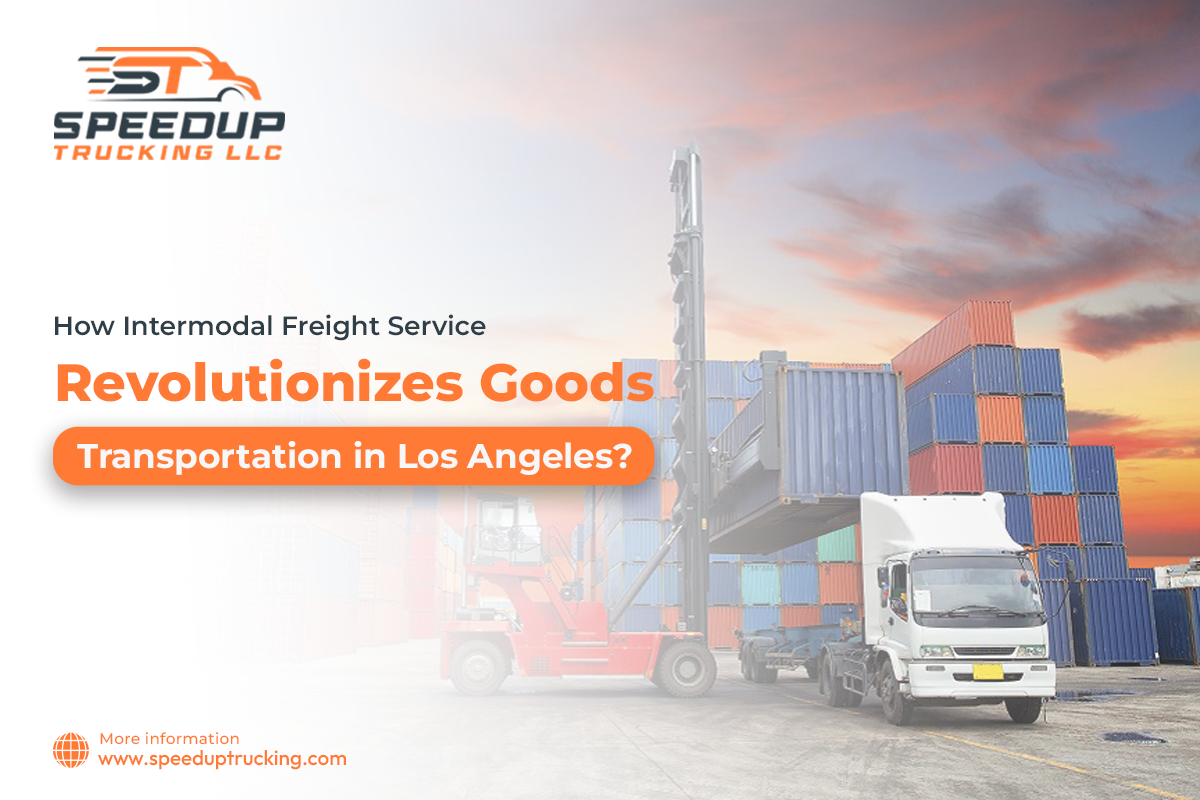Intermodal Transportation is a vital link in the supply chain, enabling the smooth and cost-efficient movement of goods. With the Port of Los Angeles being one of the busiest ports in the United States, handling an immense volume of cargo, the role of intermodal transportation becomes even more critical for the logistics industry in the region. Now, let us understand the different aspects of Intermodal transportation in detail.
What Are the Different Types of Intermodal Transportation?
The transportation industry plays a crucial role in the global economy, enabling the movement of goods and people across vast distances. One method of transportation that has gained significant popularity and efficiency is intermodal transportation. Intermodal transportation refers to the movement of cargo using two or more modes of transportation, such as trucks, trains, ships, and airplanes, in a seamless and coordinated manner.
Several different types of intermodal transportation are commonly used across the world. These include:
1. Rail and Truck: This type of intermodal transportation involves the combination of rail and truck services. It is commonly used for long-distance transportation, where goods are initially transported by rail and then transferred to trucks for final delivery. Rail and truck intermodal transportation provides a cost-effective and environmentally friendly solution for carrying large volumes of cargo over long distances.
2. Ship and Truck: Intermodal transportation using ships and trucks is widely utilized for international cargo transportation. Goods are typically transported by sea for long distances and then transferred to trucks for local or regional delivery. This type of intermodal transportation is especially beneficial for transporting goods across oceans or between continents.
3. Air and Truck: Air and truck intermodal transportation is primarily used for time-sensitive and high-value cargo. Goods are transported by air to the nearest airport and then transferred to trucks for the final delivery. This type of intermodal transportation offers fast and reliable transportation for urgent shipments.
4. Rail and Ship: Intermodal transportation using rail and ships are commonly used for transporting goods across large bodies of water, such as oceans or seas. Goods are initially transported by rail to the nearest port and then loaded onto ships for further transportation. Rail and ship intermodal transportation provides a cost-effective and efficient solution for long-distance transportation.
Advantages and Disadvantages of intermodal transportation
Intermodal transportation refers to the movement of goods using multiple modes of transportation, such as trucks, trains, ships, and airplanes, in a coordinated manner. This method offers several advantages and disadvantages that are essential to consider when evaluating its suitability for different logistical needs.
Advantages:
1. Cost-Efficiency: Intermodal transportation can be more cost-effective compared to using a single mode of transportation. By optimizing each mode’s strengths and minimizing its weaknesses, companies can reduce transportation costs significantly.
2. Flexibility: Intermodal transportation provides greater flexibility in terms of route planning and delivery options. It allows for efficient utilization of different modes of transport, ensuring that goods can be transported to various destinations effectively.
3. Reduced Congestion: Utilizing multiple modes of transportation helps alleviate traffic congestion on roads and highways. By diverting a portion of freight from trucks to trains or ships, intermodal transportation can reduce the strain on road infrastructure, leading to smoother traffic flow.
4. Environmental Benefits: Intermodal transportation has a lower carbon footprint compared to traditional transportation methods. Utilizing more fuel-efficient modes, such as trains or ships, and reducing the number of trucks on the road, helps to decrease greenhouse gas emissions and air pollution.
Disadvantages:
1. Longer Transit Time: One of the main drawbacks of intermodal transportation is the longer transit time compared to using a single mode. Coordinating different modes of transportation can introduce delays, especially when transferring goods between different carriers or terminals.
2. Handling Complexities: Intermodal transportation involves multiple handoffs and transfers between different carriers, which can introduce complexities and increase the risk of cargo damage or loss. Proper coordination and communication are essential to ensure smooth operations.
3. Infrastructure Requirements: Intermodal transportation relies on an extensive network of infrastructure, including terminals, ports, rail tracks, and intermodal yards. The availability and quality of these facilities can vary, which may limit the effectiveness and efficiency of intermodal transportation in certain regions.
4. Lack of Direct Service: In some cases, intermodal transportation may not offer direct service to certain destinations. This may require additional trucking or transshipment, increasing costs and potentially introducing more complexities.
Intermodal transportation vs multimodal transportation
Intermodal transportation and multimodal transportation are two terms that are often used interchangeably, but they refer to two distinct concepts in the field of logistics and transportation.
Intermodal transportation refers to the movement of goods using multiple modes of transportation, such as rail, road, air, and sea. In this type of transportation, the goods are typically transported in standardized containers or trailers, which can be easily transferred from one mode of transportation to another.
This allows for a seamless transfer of goods from one transportation mode to another, without the need to handle or repackage the goods.
Multimodal transportation, on the other hand, also involves the use of multiple modes of transportation, but with a key difference. In multimodal transportation, the goods are transported using a single transport operator or carrier, who is responsible for the entire transportation process. This carrier takes care of all the necessary arrangements, including the coordination of different modes of transportation, documentation, and handling of the goods.
Characteristics of intermodal transport
Key characteristics of intermodal transportation are-
1. Accessibility: One of the primary characteristics of intermodal transport is its accessibility. By combining different modes of transportation, intermodal transport provides businesses with a wide range of options to move their goods. It allows for seamless movement between different transportation networks, enabling goods to reach their destination more efficiently.
2. Efficiency: Intermodal transport is known for its efficiency. By utilizing various transportation modes, it optimizes the use of infrastructure and resources. This results in reduced transportation costs and faster delivery times compared to relying on a single mode of transport. Moreover, intermodal transport often involves standardized containers, which further enhances efficiency by facilitating easy transfer between different modes of transportation.
3. Flexibility: Another characteristic of intermodal transport is its flexibility. It allows businesses to adapt to changing market conditions and customer demands. With intermodal transport, companies can choose the most suitable combination of transportation modes based on factors such as cost, time sensitivity, and the nature of the goods being transported. This flexibility enables businesses to optimize their supply chain and enhance their overall operational efficiency.
4. Sustainability: Intermodal transport is considered a more sustainable option compared to traditional transportation methods. By utilizing different modes of transportation, it helps reduce carbon emissions and minimize the environmental impact. For example, shifting a significant portion of cargo from road to rail can result in substantial fuel savings and lower greenhouse gas emissions. Additionally, intermodal transport reduces traffic congestion and lowers the overall carbon footprint.
5. Reliability: Intermodal transport offers a high level of reliability. By diversifying transportation modes, it reduces the risk of disruptions and delays. If one mode of transport encounters an issue, goods can be seamlessly transferred to an alternative mode, ensuring timely delivery. This reliability is crucial for businesses that require consistent and predictable transportation services.
6. Global Connectivity: Intermodal transport provides global connectivity, allowing businesses to access markets worldwide. It enables the efficient movement of goods across different countries and continents, connecting businesses with suppliers, manufacturers, and customers across the globe. This global connectivity opens up new opportunities for international trade and economic growth.
Conclusion
Intermodal freight service in Los Angeles, plays a crucial role in facilitating the efficient and cost-effective transportation of goods. As one of the busiest ports in the United States, the Port of Los Angeles handles a significant amount of cargo, making the intermodal freight service an essential component of the logistics industry in the region. By efficiently integrating multiple modes of transportation, it helps businesses move goods from the bustling Port of Los Angeles to their intended destinations across the country, contributing to a well-functioning and dynamic supply chain network.


